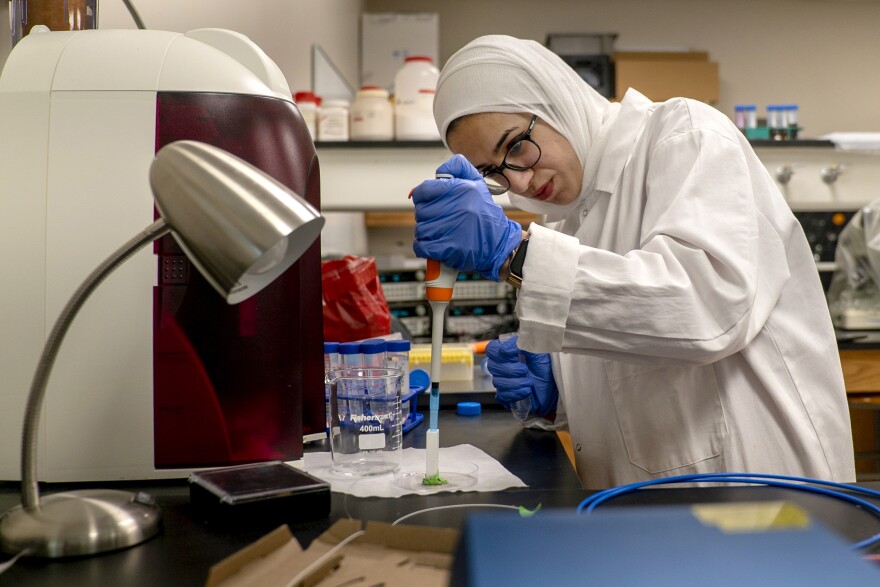A team of scientists from five universities, led by the University of Missouri, developing new ways to quickly detect and track the potential of salmonella contamination in the poultry supply chain is getting millions of dollars more to fund the research.
The project, called Sens-D, is one of seven projects moving forward in the National Science Foundation’s Convergence Accelerator Program track aimed at tackling food and nutrition insecurity challenges. Sens-D is now eligible for $5 million in grant funding to further support its research and development over the next three years.
That means moving from early prototypes to a salmonella testing system that could conceivably hit the market to boost the overall safety of the food supply chain, said Kate Trout, one of the project’s principal investigators and an assistant professor of health sciences at the University of Missouri.
“We’re not only doing research and development, we are also developing a sustainability plan,” she said, “to make sure this gets out into society in three years once we’ve actually built our high-fidelity prototypes and have all of our pieces functioning together.”
Part of the research includes the development of new physical sensors to quickly detect low concentrations of salmonella from a sample while fulfilling the Association of Official Analytical Chemists (AOAC) requirement for detection of salmonella serovars in poultry products, said lead principal investigator Mahmoud Almasri.
This next phase of research will build on three prototype sensors that have already been developed, said Almasri, an associate professor of electrical engineering and computer science at Mizzou.
“This year we’re basically going to be optimizing the sensors,” he said, “to give us the best results in terms of being able to differentiate serotypes, being able to quantify the salmonella, to tell what’s the concentration.”

Almasri explained that salmonella has thousands of serotypes, or breeds of the pathogen, that differ in their genetic material. Some 15 or so that are found in poultry are important to pay attention to, he said.
“In this phase we will be targeting (our sensors to detect) four of them,” Almasri said. “If we’re able to detect four, we should be able to detect the rest.”
Part of the development includes putting the different sensors into portable systems where they can work together and transmit that data to the cloud, Trout said.
“That’s where we are building the sensing instrument that is portable, user friendly, easy to use, cost effective, that will integrate data, make better decisions, a better environment for our decision support system,” she said.
That’s another part of the research, to use the data from the sensors and integrate it into an accompanying software system that uses other data sources to track salmonella contamination in the poultry supply chain, said Haitao Li, another one of the project's principal investigators and a chair of the supply chain and analytics department at the University of Missouri-St. Louis.
“And beyond that our capability to be able to predict the incidence of salmonella as well as the shelf time of these perishable products,” he said.
Li said the eventual decision support system could offer visualizations of where potential contamination is concentrated in the supply chain and optimization for how to distribute the product.
The products of this research and development are ones the poultry industry is interested in, said James Rohl, the project’s manager.
“One of the neatest things about the project is that industry has been so responsive in seeing that this is really fulfilling a real need,” he said.
Other members of the Sens-D team agree, including Amit Morey, a co-principal investigator and professor of poultry science at Auburn University.
“It’s going to add tremendous firepower to their arsenal in terms of making decisions to improve food safety,” he said.
But that doesn’t mean it’s trivial to collaborate across fields and universities, he said. The Sens-D team includes 19 investigators spread across five academic institutions: the University of Missouri, the University of Missouri-St. Louis, Lincoln University, the University of Notre Dame and Auburn University.
“This kind of interdisciplinary, large-team science, it’s not easy. All of us are experts in our own areas,” Trout said. “Even the language that we speak, it takes longer to understand each other.”
One example is the term “AI,” said co-principal investigator Tim Safranski, a professor of animal sciences at Mizzou.
“I can guarantee there are more manuscripts with ‘AI’ in the title on my CV than anyone else because I have been teaching swine artificial insemination for 28 years,” he said. “And yet we are bringing in AI experts because I don’t know anything about artificial intelligence.”
It may be challenging, but the researchers on the Sens-D team say it’s rewarding to tackle a big problem like reducing salmonella contamination.
“This truly converges several disciplines that otherwise would not talk to each other to solve some of the most complex problems that otherwise were not being solved,” Morey said.
The expanded funding from the National Science Foundation gives the research team a few more years to build products that would be ready for the commercial market, Trout said.
“We’re exploring multiple things and haven’t landed on a specific sustainability option yet, but it’s very possible after three years we will have some sort of entity, whether nonprofit, NGO, for-profit, we haven’t landed on specifics,” she said.
Part of that is because a single end user might not need to use all the new sensors and the software being developed, Safranski said.
“The different tools might have very different audiences,” he said. “(We’re) trying to have the intellectual property protected in ways that make it most usable.”






